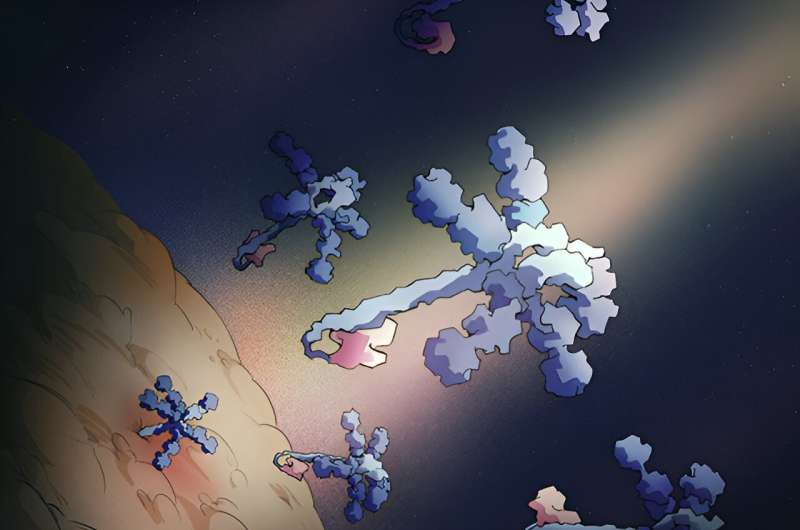
Researchers have discovered toxic protein particles, shaped like umbrellas, that soil bacteria known as Streptomyces secrete to squelch competitors, especially others of their own species.
The discovery of the umbrella toxin particles and related information about their structures, composition, and mode of action were published in Nature.
The umbrella toxin proteins are the latest example of these bacteria’s varied, combative strikes on their microscopic rivals. The crowded, diverse bacteria communities in which they live are a melee of antimicrobial attacks, counterattacks, and defenses.
Ironically, many clinically used antibiotics are derived directly from, or are inspired by, molecules that bacteria use against each other in their natural habitat. Streptomyces’ chemical weaponry against their competitors is one of the richest sources of such molecules. Among them is the common, broad-spectrum drug streptomycin.
What makes these newly detected antibacterial toxins different is that, unlike the Streptomyces’ small-molecule antibiotics, umbrella toxins are large complexes composed of multiple proteins. They are also far more specific in the bacteria they target.
The authors of the paper speculate that these properties of umbrella toxins explain why they escaped discovery for more than 100 years of research on toxins produced by Streptomyces.
Genes encoding umbrella toxins were originally uncovered through a bioinformatics search for new bacterial toxins. In biochemical and genetic experiments led by Qinqin Zhao in Joseph Mougous’ microbiology lab at the University of Washington School of Medicine, the scientists learned that these toxins are associated with other proteins in a large complex.
Cryo-electron microscopy of these protein complexes was performed by Young Park in the laboratory of David Veesler, professor of biochemistry at the UW School of Medicine and an investigator of the Howard Hughes Medical Institute.
These studies revealed that the toxin complexes Qinqin isolated adopt a striking appearance befitting their discovery in Seattle. They look like umbrellas.
“The shape of these particles is quite peculiar, and it will be interesting in future work to learn how their unusual morphology helps them eliminate target bacteria,” noted Mougous, a professor of microbiology at the UW School of Medicine and a Howard Hughes Medical Institute investigator.
The scientists then sought to determine the targets of these toxins by screening their effects on every organism they could conceivably target, from fungi to 140 different bacteria, including some taken from sorghum plants in the lab of study author Devin Coleman at the University of California-Berkeley and the U.S. Department of Agriculture Agricultural Research Service.
Among these potential adversaries, the toxins specifically targeted their own brethren: other Streptomyces species.
“We think this exquisite specificity may be due to the proteins that make up the spokes of the umbrella, which vary across the particles. These include proteins that might latch onto specific sugars found on the surface of competitor bacteria,” commented study author S. Brook Peterson, a senior scientist in the Mougous lab.
By analyzing the thousands of publicly available bacterial genomes, study authors Dapeng Zhang of St. Louis University and his graduate student Youngjun Tan found that many other species of bacteria also have the genes to manufacture umbrella particle toxins. Interestingly, these species all form branching filaments, an unusual mode of growth among bacteria.
In addition to the many questions remaining to be answered about the basic biology of umbrella toxin particles, Mougous and his colleagues are intrigued by their potential clinical applications.
They suspect that the bacteria that cause tuberculosis and diphtheria may be sensitive to umbrella toxins. They note these same bacteria have become resistant to traditional antibiotics. Umbrella toxin particles might be worth exploring, the scientists suggested, for their potential to subdue these serious disease-causing bacteria.
More information:
Joseph Mougous et al, Streptomyces umbrella toxin particles block hyphal growth of competing species, Nature (2024). DOI: 10.1038/s41586-024-07298-z. www.nature.com/articles/s41586-024-07298-z
Journal information:Nature
Provided by
University of Washington School of Medicine

READ MORE
‘Nanozyme’ therapy prevents harmful dental plaque build-up
Pairing iron oxide nanoparticles with hydrogen peroxide results in a precisely targeted treatment for killing [...]
New Devices Could Change the Way We Measure Blood Pressure
If just by looking at our watch or cellphone we can know, in real time, [...]
Why are thieves looking for suction cup marks on your car’s front window?
Those telltale suction cup marks on your windshield can make your car a target for [...]
New technique for sorting micro-particles uses sound waves
Schematic diagram of an acoustofluidic chip for shape-based separation. a A schematic diagram of the [...]
What happens when the child becomes the parent?
Taking care of your parents later in life is an important responsibility not to be [...]
New nanowire sensors are the next step in the Internet of Things
Credit: CC0 Public Domain A new miniscule nitrogen dioxide sensor could help protect the environment [...]
New technique accurately measures how 2D materials expand when heated
Understand thermal expansion via the coupled temperature and substrate effect on phonon modes. Credit: Science [...]
How to Replace a Power Steering Pump
A power steering pump helps reduce the effort needed to steer the car by exerting [...]